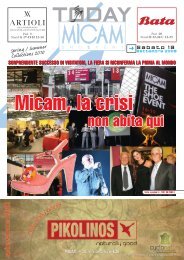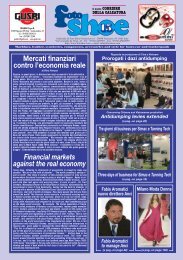I cop VM EXPORT Fs30_9 - Editoriale di Foto Shoe Srl
I cop VM EXPORT Fs30_9 - Editoriale di Foto Shoe Srl
I cop VM EXPORT Fs30_9 - Editoriale di Foto Shoe Srl
You also want an ePaper? Increase the reach of your titles
YUMPU automatically turns print PDFs into web optimized ePapers that Google loves.
MARKETS<br />
<strong>di</strong> Barbara Solini<br />
30<br />
Anci presents the sector’s economic situation<br />
Italian footwear<br />
within the general<br />
crisis scenario<br />
falling consumption and a slowdown in international tra<strong>di</strong>ng<br />
following the financial crisis that began in the last quarter of<br />
2008 have had a significant impact on the Italian footwear<br />
manufacturing industry that exports some 80% of its production.<br />
Fortunately, in the case of footwear, it is not a total collapse:<br />
in fact in recent years the sectors’ companies have<br />
focused on repositioning their product in the top bracket and<br />
on internationalisation/<strong>di</strong>versification of market outlets, a strategic<br />
choice that has enabled many to withstand the impact of the crisis<br />
and limit damages.<br />
Thus 2008 came to a close “browbeaten” by the sharp drop of the last<br />
quarter but not completely flattened. Accor<strong>di</strong>ng to Anci’s interpretation<br />
of Istat figures, in 2008 production dropped by 6.9% in volume<br />
and 2% in value, settling at 225.2 million pairs for a total of 7.3 billion<br />
Euros. These figures were affected by the drop in exports: -9.6%<br />
in quantity (221.8 million pairs) on an annual basis, with a still positive<br />
value of 6.9 billion Euros (+0.5%), due to the effect of the – certainly<br />
not marginal – increase in average price (+11.2%). However, if<br />
we look at data regar<strong>di</strong>ng the last quarter only, we can see the dramatic<br />
entity of the crisis: -18% in quantity.<br />
This falling trend also hailed the beginning of 2009: -14.25% in quantity<br />
and –7.35% in value (42.3 million pairs for 1,273.19 million<br />
Euros) less in the first two-month period, compared with the same<br />
period of 2008. It should be noticed that, in spite of the +8.04%<br />
increase in the average price, the value of exports remain negative.<br />
A negative performance was also registered on many of the Italian<br />
product’s tra<strong>di</strong>tional markets. Whilst there was a resoun<strong>di</strong>ng fall in<br />
the United States (-22.42% in quantity and –17.10% in value) and in<br />
England (-27% and –15.21), the two countries hardest hit by the<br />
financial crisis, Germany too showed negative signs (-17.35 and<br />
–5.95) as <strong>di</strong>d France (-12.14% but +1.91% in value). Spain (+8.96%<br />
and +18.50%), Switzerland (+9.47% and +14.7%), and Greece<br />
(+12.16% and +17.18%) showed positive signs, as <strong>di</strong>d East European<br />
and CIS countries (+11.6% in value), particularly Russia (+2.96% and<br />
+15.18%).<br />
In 2008, a drop was also seen in Italian imports, further confirmation<br />
of falling domestic consumption: -9.59% in quantity and +4.62% in<br />
value for a total of 352.6 million pairs (37 less than in 2007). In the<br />
list of importing countries, China and Vietnam, respectively with<br />
–18% and +12.5% in quantity, remained the top supplier countries.<br />
The 2008 trade balance shows negative signs in quantity: -130.9 million<br />
pairs (-13.8%) and a drop in value: 3,564.72 million Euros (-<br />
3.08%).<br />
In this context, 187 companies closed (-2.90%) and 2,750 employees<br />
lost their jobs (-3.10): a situation of suffering that is confirmed by<br />
the increased use of the redundancy fund (+36.03%).<br />
In conclusion, after a <strong>di</strong>sappointing but relatively steady 2008, 2009<br />
Anci presenta i dati <strong>di</strong> congiuntura <strong>di</strong> settore<br />
La calzatura italiana<br />
nel quadro generale<br />
della crisi<br />
il crollo dei consumi e il rallentamento del commercio internazionale<br />
seguito alla crisi finanziaria dell’ultimo trimestre<br />
2008 ha inciso in modo significativo sul settore calzaturiero<br />
italiano che destina all’esportazione ben l’80% della propria<br />
produzione. Fortunatamente, nel caso della calzatura, non<br />
si tratta <strong>di</strong> un tracollo: negli anni scorsi, infatti, le aziende<br />
del settore avevano già puntato su un riposizionamento sull’alta<br />
gamma e sull’internazionalizzazione/<strong>di</strong>versificazione dei mercati <strong>di</strong><br />
sbocco, una scelta strategica che ha permesso a molti <strong>di</strong> sopportare<br />
l’urto della crisi e contenerne i danni.<br />
Così il 2008 esce “abbacchiato” dalla brusca frenata del quarto trimestre,<br />
ma non a terra. Secondo i dati elaborati da Anci su base<br />
Istat, la produzione nel 2008 cala del 6,9% in volume e del 2% in<br />
valore, assestandosi a 225,2 milioni <strong>di</strong> paia per un totale <strong>di</strong> 7,3<br />
miliar<strong>di</strong> <strong>di</strong> euro. Un dato sul quale ha inciso il calo dell’export: -<br />
9,6% in quantità (221,8 milioni <strong>di</strong> paia) su base annua, con un valore<br />
ancora positivo <strong>di</strong> 6,9 miliar<strong>di</strong> <strong>di</strong> euro (+0,5%), per effetto dell’aumento<br />
– certamente non marginale - del prezzo me<strong>di</strong>o<br />
(+11,2%). Ma, se ve<strong>di</strong>amo il dato relativo al solo ultimo trimestre, si<br />
comprende la drammatica entità della crisi: -18% in quantità.<br />
Un trend in calo che segna <strong>di</strong> rosso anche l’inizio del 2009: -14,25%<br />
in quantità e -7,35% in valore (42,3 milioni <strong>di</strong> paia, per 1.273,19<br />
milioni <strong>di</strong> euro) in meno nel primo bimestre, rispetto allo stesso<br />
periodo del 2008. Si rileva che, nonostante l’aumento del prezzo<br />
me<strong>di</strong>o del +8,04%, il valore dell’export resta comunque negativo.<br />
Negative la performance in molti mercati <strong>di</strong> sbocco tra<strong>di</strong>zionali del<br />
made in Italy. Se è clamoroso il calo in Usa (-22,42% in quantità e<br />
-17,10% in valore) e in Inghilterra (-27% e -15,21), i due Paesi che<br />
hanno risentito maggiormente il peso della crisi finanziaria, si registrano<br />
con segno negativo anche Germania (-17,35 e -5,95), Francia<br />
(-12,14%, ma +1,91% in valore). In positivo, Spagna (+8,96% e<br />
+18,50%), Svizzera (+9,47% e +14,7%), Grecia (+12,16% e<br />
+17,18%) oltre nei paesi dell’Est Europa e della CSI (+11,6% in valore),<br />
in particolare Russia (+2,96% e +15,18%).<br />
Cala anche l’import in Italia nel 2008, un segno dell’ulteriore contrazione<br />
dei consumi interni: -9,59% in quantità e +4,62% in valore,<br />
per un totale <strong>di</strong> 352,6 milioni <strong>di</strong> paia (37 in meno rispetto al<br />
2007). Nella lista dei paesi importatori, Cina e Vietnam, rispettivamente<br />
con -18% e +12,5% in quantità, restano in cima alla lista dei<br />
fornitori.<br />
Il saldo della bilancia commerciale del 2008 presenta un saldo<br />
negativo in quantità: -130,9 milioni <strong>di</strong> paia (-13,8%), e in calo per il<br />
valore: 3.564,72 milioni <strong>di</strong> euro (-3,08%).<br />
In questo quadro, chiudono 187 aziende (-2,90%) e perdono il<br />
posto <strong>di</strong> lavoro 2750 addetti (-3,10): un quadro si sofferenza che si<br />
vede confermato nell’aumento del ricorso alla Cassa Integrazione<br />
(+36,03%).
















